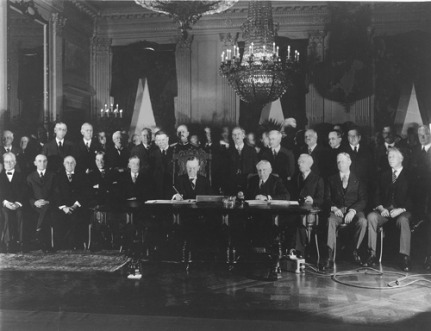LAD/Blog #33: Kellogg-Briand Peace Pact
LAD/Blog #33: Kellogg-Briand Peace Pact:
The Kellogg-Briand Pact, or the Pact of Paris, was signed in the 1928 as an agreement to outlaw war to prevent another conflict. The French Minister of Foreign Affairs, Aristide Briand, proposed the pact as an agreement between France and the United States to avoid war between them. However, President Coolidge and Frank B. Kellogg, the Secretary of State, were not completely supportive of the agreement and worried it would be considered an alliance which US would have to intervene if France was ever threatened. Therefore, they proposed that all nations be invited to outlaw war. The Pact agreed to outlaw war and use signatures to settle disputes in a peaceful manner. On August 27, 1928, fifteen countries signed the Kellogg-Briand Pact (France, the United States, the United Kingdom, Ireland, Canada, Australia, New Zealand, South Africa, India, Belgium, Poland, Czechoslovakia, Germany, Italy and Japan). Eventually, other nations signed the pact as well. The Mukden Incident was the first test of the pact. This incident caused Japan to invade Manchuria and since the world was in a depression and did not want to go to war to preserve China, no one enforced the Pact. This demonstrates how the Kellogg-Briand Pact failed to prevent militarism but represented the idealism of the time.
The Kellogg-Briand Pact, or the Pact of Paris, was signed in the 1928 as an agreement to outlaw war to prevent another conflict. The French Minister of Foreign Affairs, Aristide Briand, proposed the pact as an agreement between France and the United States to avoid war between them. However, President Coolidge and Frank B. Kellogg, the Secretary of State, were not completely supportive of the agreement and worried it would be considered an alliance which US would have to intervene if France was ever threatened. Therefore, they proposed that all nations be invited to outlaw war. The Pact agreed to outlaw war and use signatures to settle disputes in a peaceful manner. On August 27, 1928, fifteen countries signed the Kellogg-Briand Pact (France, the United States, the United Kingdom, Ireland, Canada, Australia, New Zealand, South Africa, India, Belgium, Poland, Czechoslovakia, Germany, Italy and Japan). Eventually, other nations signed the pact as well. The Mukden Incident was the first test of the pact. This incident caused Japan to invade Manchuria and since the world was in a depression and did not want to go to war to preserve China, no one enforced the Pact. This demonstrates how the Kellogg-Briand Pact failed to prevent militarism but represented the idealism of the time.
 |
| This is similar to the Treaty of Versailles which followed WWI and was too idealistic leading to its failure. |

Comments
Post a Comment